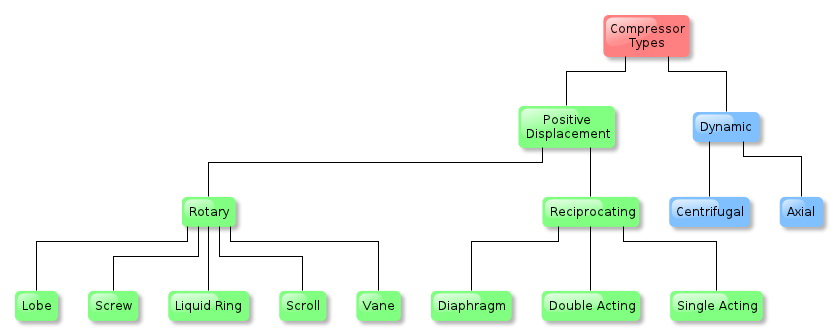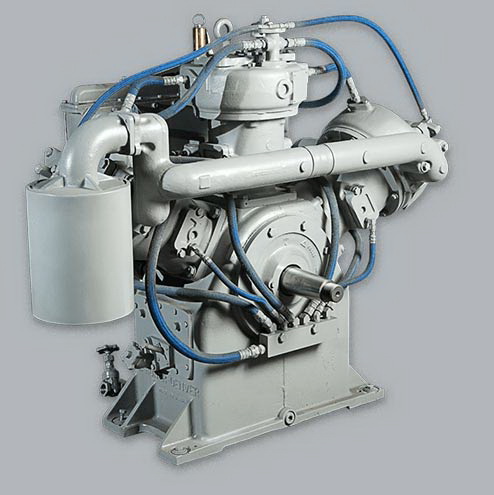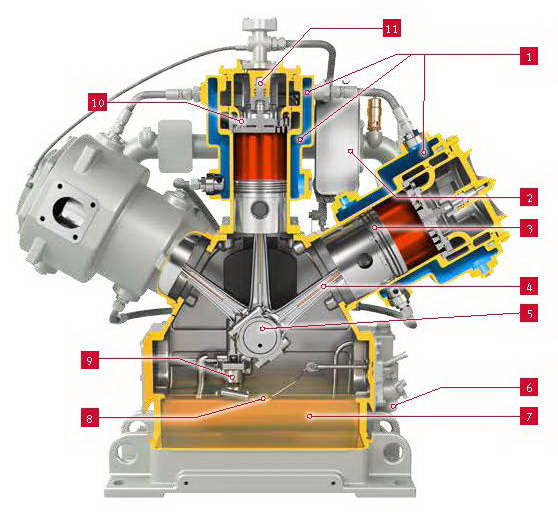
What is air compressor?
An air compressor is a device that converts power (using an electric motor, diesel or gasoline engine, etc.) into potential energy stored in pressurized air (i.e., compressed air).
By one of several methods, an air compressor forces more and more air into a storage tank, increasing the pressure. When tank pressure reaches its engineered upper limit the air compressor shuts off. The compressed air, then, is held in the tank until called into use. The energy contained in the compressed air can be used for a variety of applications, utilizing the kinetic energy of the air as it is released and the tank depressurizes. When tank pressure reaches its lower limit, the air compressor turns on again and re-pressurizes the tank.
Classification method of compressors:
Compressors can be classified according to the pressure delivered:
- Low-pressure air compressors (LPACs), which have a discharge pressure of 150 psi or less
- Medium-pressure compressors which have a discharge pressure of 151 psi to 1,000 psi
- High-pressure air compressors (HPACs), which have a discharge pressure above 1,000 psi
They can also be classified according to the design and principle of operation:
- Rotary-Screw Compressor
- Turbo Compressor
 |
| Compressor Classification Chart |
Displacement type:
Displacement type of compressors is clessified into:
1-Positive Displacement:
- Piston type
- Rotary Screw Compressor
- Vane Compressor
2- Dynamic Displacement
- Centrifugal Compressor
- Axial Compressor
Cooloing Method:
Due to adiabatic heating, air compressors require some method of disposing of waste heat. Generally this is some form of air- or water-cooling, although some (particularly rotary type) compressors may be cooled by oil (that is then in turn air- or water-cooled) and the atmospheric changes also considered during cooling of compressors.
Usage purposes of Air Compressors:
Air compressors have many uses, including: supplying high-pressure clean air to fill gas cylinders, supplying moderate-pressure clean air to a submerged surface supplied diver, supplying moderate-pressure clean air for driving some office and school building pneumatic HVAC control system valves, supplying a large amount of moderate-pressure air to power pneumatic tools, such as jackhammers, filling high pressure air tanks (HPA), for filling tires, and to produce large volumes of moderate-pressure air for large-scale industrial processes (such as oxidation for petroleum coking or cement plant bag house purge systems).
Most air compressors either are reciprocating piston type, rotary vane or rotary screw. Centrifugal compressors are common in very large applications. There are two main types of air-compressor pumps: oil-lubed and oil-less. The oil-less system has more technical development, but is more expensive, louder and lasts for less time than oil-lubed pumps. The oil-less system also delivers air of better quality.
The most common types of air compressors are: electric or gas/diesel powered compressors. The power of a compressor is measured in HP (horsepower) and CFM (Cubic feet per minute of intake air). The gallon size of the tank specifies the volume of compressed air (in reserve) available. Gas/diesel powered compressors are widely used in remote areas with problematic access to electricity. They are noisy and require ventilation for exhaust gases. Electric powered compressors are widely used in production, workshops and garages with permanent access to electricity. Common workshop/garage compressors are 110-120 Volt or 230-240 Volt. Compressor tank shapes are: "pancake", "twin tank", "horizontal", and "vertical". Depending on a size and purpose compressors can be stationary or portable.
Reciprocating compressors
Reciprocating compressors use pistons driven by a crankshaft. They can be either stationary or portable, can be single or multi-staged, and can be driven by electric motors or internal combustion engines. Small reciprocating compressors from 5 to 30 horsepower (hp) are commonly seen in automotive applications and are typically for intermittent duty. Larger reciprocating compressors well over 1,000 hp (750 kW) are commonly found in large industrial and petroleum applications. Discharge pressure can range from low pressure to very high pressure (>18000 psi or 180 MPa). In certain applications, such as air compression, multi-stage double-acting compressors are said to be the most efficient compressors available, and are typically larger, and more costly than comparable rotary units. Another type of reciprocating compressor, usually employed in automotive cabin air conditioning systems, is the swash plate compressor, which uses pistons moved by a swash plate mounted on a shaft.
Household, home workshop, and smaller job site compressors are typically reciprocating compressors 1½ hp or less with an attached receiver tank.
W-Type locomotive compressors:
Most famous compressors that are used on locomotives are W-Type (i.e. WBO, WLN, WLU, etc.). Air-cooled compressors came into use in the 1940’s for diesel electric freight locomotives.
The features at a glance for W-Type compressors are:
- Air or Water Cooled Compressors and Compressor/Exhausters
- 3, 4 and 6 cylinder models
- Designed for harsh enviroments such as tropical heat, desert sandstorms, monsoons and arctic cold
- Pistons, rings and cylinders designed for optimum oil control
- Rifle drilled connecting rods provide pressurized lubrication to the wrist pin for low speed operation
- Ductile iron crankshaft is precison designed and supported by large tapered roller bearings
- Full flow spin-on oil filter
- Low lift valves
- Float with oil level gauge
- Large capacity oil crankcase
As a part of locomotive components and acknowledge of effective operatioanl time of locomotive ans also costly downtime of locomotive, servicibility of locomotive air compressor is a key subject.
To acheive this goal:
- Compressors include valve designs that are reliable, highly efficient, easy to access and quick to replace
- The large oil capacity increases oil life and reduces service intervals
- Gear-driven positive displacement oil pump provides pressurized lubrication under all operating conditions
- Exclusive Gardner Denver piston and piston ring designs significantly reduce oil carry over
- The oil level gauge and float design allows for positive oil level indication
 |
All above said, W-Type compressor have been desigend in a manner to:
- Easy access to internal parts
- Quick change and replacement.
- Lowering lubrication oil temperature by using higher volume of oil.
- High efficiency Positive Replacement Lube Oil Gear Pump.
Practically W-Type compressors have been desigend to perform in harsh environments such as tropical heat, desert sandstorms, monsoons and arctic cold.
Locomotive Compressor Features:
 |
- Choice of air or water cooled compressors. Water cooled models have cylinders and valve pockets fully jacketed for maximum heat dissipation.
- Welded plate intercooler for reduced weight and better leakage control.
- Pistons, rings and cylinders are designed for optimum oil control. Cylinders are manufactured to gauge quality roundness, with tolerances measured in millionths of an inch. Exclusive Gardner Denver piston and piston ring design significantly reduces oil carry over into the air stream.
- Rifle drilled connecting rods provide pressurized lubrication to the wrist pin for low speed operation.
- Ductile iron crankshaft, single or double ended, is precision designed and supported by large tapered roller bearings, with drive gear for the oil pump. Bearings have a B-10 life of 75,000 hours.
- Full flow, spin on oil filter for improved life and reliability.
- Large oil capacity crankcase prolongs oil life and reduces maintenance costs by lowering oil temperatures.
- Float style oil level gauge for positive oil level indication. Oil level dipstick is optional.
- Positive displacement oil pump, gear driven by the compressor crankshaft, provides pressurized lubrication under all operating conditions, including low idle speed.
- Low lift valves for improved volumetric efficiency and reliability at high engine speeds. Both traditional and concentric valve options are available.
- Low maintenance unloaders.
Rated speed for WBO or WLN compressors: 1050 RPM
Rated pressure for WBO or WLN compressors: 140 psi
Displacement at rated speed 296 CFM
68 HP at rated speed and pressure
References:
- Gardner Denver
- Wabtec
- Woodward
- Wikipedia
- Technical Documents of EMD

